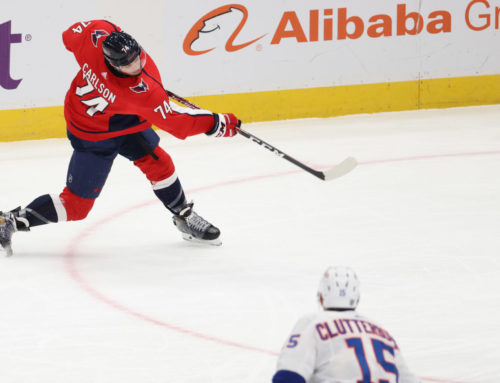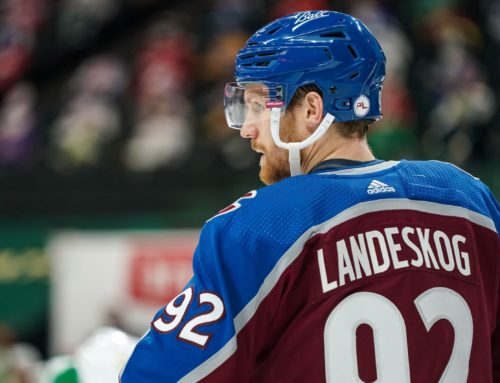Capped: Options for Jordan Binnington and St. Louis
Alexander MacLean
2019-06-13

St. Louis Blues GM Doug Armstrong has been in his role with the team since 2010, and has had his fair share of goalie controversies in that time. He managed Jake Allen’s contract situation very well, and that should give Blues fans confidence when looking towards the inevitable re-signing of Jordan Binnington this summer. On the other hand, there has never quite been a situation like this in the salary cap era, and it makes for a very intriguing case study.
Whatever happens in game seven tonight, the Blues are in an excellent cap situation this summer. They have only a half-a-dozen depth players to sign on top of Binnington, and a projected $36 million to work with (those are the kind of numbers that imply a big swing for a repeat finals appearance next summer).
****
Comparables
In the salary cap era, there are three decent comparables to what Binnington is doing this season – Matt Murray (2016), Andrew Hammond (2015), and Cam Ward (2006). Both Murray and Ward won the Stanley Cup as a rookie goaltender at the age of 22, doing a lot of the heavy lifting along the way. Hammond however, only played two games of the 2015 playoffs, showing cracks that weren’t there during his spectacular regular season run. The “Hamburgler” as he was affectionately dubbed, has played 34 NHL games since, and never really was able to recapture the magic from his initial run. Murray and Ward on the other hand, have had varying degrees of success in their careers since, but both have been NHL-caliber goaltenders since their Cup runs. Binnington falls firmly into the camp with Murray and Ward (with or without a cup tonight).
Additionally, many NHL executives, scouts, and players praise Binnington for his calmness in the crease, his confidence in his play, and his technique that is extremely sound. All signs point to the St. Louis netminder panning out as a long-term NHL asset. What remains uncertain is what degree of success can we expect from Binnington moving forward. Does he follow down Ward’s path of never quite matching his rookie season form, or does he find the Murray recipe for success and put up some all-star worthy numbers when healthy? The safe bet is somewhere in between, but based on the talent on the Blues team in front of Binnington, it makes sense to shift his expectations a little higher than just the average, and closer (if not higher) than what Murray has done in his three full seasons.
The unfortunate part for comparison’s sake, is that when Murray and Ward won their rookie cups, they were both still under contract the next year. That being said, Murray did sign his extension that summer, and it mirrored Ward’s next contract almost exactly. In both cases, the second contract was a three-year deal, worth with a cap hit percentage of 5.3% for Ward ($2,666,667), and 5.14% for Murray ($3,750,000). This type of contract could make sense for Binnington as well, if it weren’t for a couple other contributing factors. Let’s get into those now.
*
The Jake Allen Factor
Before dealing with Jordan Binnington’s work load for next year, we must first review Jake Allen, and his expected role. Typically, in NHL circles, the goalie with the larger contract will receive the lion’s share of the starts, rightfully or not, so that he can earn his contract. Jake Allen has done his best to work against that every chance he has gotten. His first four years in the NHL, he posted excellent regular season numbers, and was underpaid (on his ELC and a bridge deal), having to earn his way into more starts based purely on performance. Since he signed his bigger contract two seasons ago, he has really struggled with the starter’s role, even though he keeps getting force-fed starts. He dipped from 59 games two years ago, to 46 this past season, and I think we see that drop again to the 40-game range next season. His contract, service time with the team, in addition to a reduced pressure and workload will mean Allen’s numbers bounce back slightly, earning him these 40 starts instead of having them fall in his lap.
Binnington on the other hand, will start the other half of the games. The Blues planning for this kind of usage ahead of time would be the best-case scenario for all involved. Binnington can work with a reduced load in his first full season, be ready for playoff time, and when the inevitable bad bounces come his way, he knows he doesn’t have to start every game, and can come back fresh after taking a night off without having to worry about ceding the crease to Allen full time.
*
Contract Length
From my contract prediction series last January, I had two main points when estimating contract details: role, and age. We defined Binnington’s role about as a 1A goalie in an even platoon, like what Lehner was to the Islanders this past season. Binnington’s age is then our next topic, and it muddles the water even further. Ideally for the Blues, the 25-year-old Binnington would have come up earlier and had more time before his RFA status expires (summer of 2021). As it is, the Blues have two summers of RFA status to work with, meaning they have three options.
- Sign Binnington to a one-year bridge deal, and then have a full season under his belt before locking him up long-term at a fair price.
- Sign him to a two-year bridge deal, walk him straight to free-agency, and what would likely be an overpay if they want to keep him.
- Sign him to a long-term, six or seven-year deal, and take the risk that this is not just a hot run that will all come crashing down.
What is the lesser of those three evils? I was not able to find a single goaltender that had gone straight from their ELC to a big payday ($4 million+), so it appears that around the league GMs are cautious with paying goaltenders, knowing they take longer to develop, and fluctuate more than skaters.
That leaves the one- or two-year options. And after Binnington’s rise in these playoffs, having him walk to the UFA market in two seasons would be a black mark on the Blues franchise, so they will avoid that as much as possible, option to push for the one-year bridge deal route. On the flip side, the Binnington camp will want more than one year of commitment based on his run of success. Where then is the middle ground? It may end up coming down to salary arbitration.
*
Estimating Contract Amounts
If Binnington blazes a trail and signs a large deal straight out of his ELC, there is no benchmark. He would likely look at recent third contracts signed by young goalies such as Connor Hellebuyck and John Gibson, at around eight percent of the salary cap. With the rising cap, that would likely set Binnington over $6.5 million per season, at a length of six or seven years. Less likely, but certainly plausible.
The amount on a shorter-term deal would likely be similar to the Ward and Murray contracts discussed above. A cap hit at 5.24% of the cap limit would match Jake Allen’s cap number exactly, while making for a simple solution to the negotiations in the short term. However, due to the cap space of the Blues, and the assumed desire for a one-year “show me” contract while retaining Binnington’s RFA status for next summer, they could pay him a cool $5 million for next year and have it all settled.
****
I also wanted to touch on Jeff Skinner. The $9 million price tag is high for what he has done, especially when considering that the last time he signed a long-term deal over the summer, he went out to post the lowest totals of his career, and the second lowest point pace. A career high shooting percentage helped him to a career high 40-goal season, but it was Jack Eichel that really fueled the fire. Through half of a season, Eichel was Skinner’s most common linemate, and Skinner put up a point per game. In the second half, Skinner dropped to almost half of that. Whether Skinner lives up to this contract at all is not going to be due to fluctuations in shooting percentage, or even ice time highs, or a powerplay mark over three minutes, it will be about Eichel. If the Sabres attach Skinner to Eichel’s hip, then he can produce 40 goals and 30 assists for the next few years. For a $9 million price tag, that’s exactly what you get: every opportunity with the top guns, to produce like a top gun.
This all being said, $9 million is about $1.5 million more than Skinner’s market worth, and the length of the contract isn’t pretty, but depending on how the cap rises, it may not be as awful as people are saying.
****
All salary info courtesy of capfriendly, all statistics are pulled from FrozenTools.
You can find me on Twitter @alexdmaclean.





 BUF
BUF N.J
N.J PHI
PHI MIN
MIN FLA
FLA WPG
WPG VAN
VAN TOR
TOR CGY
CGY NYR
NYR